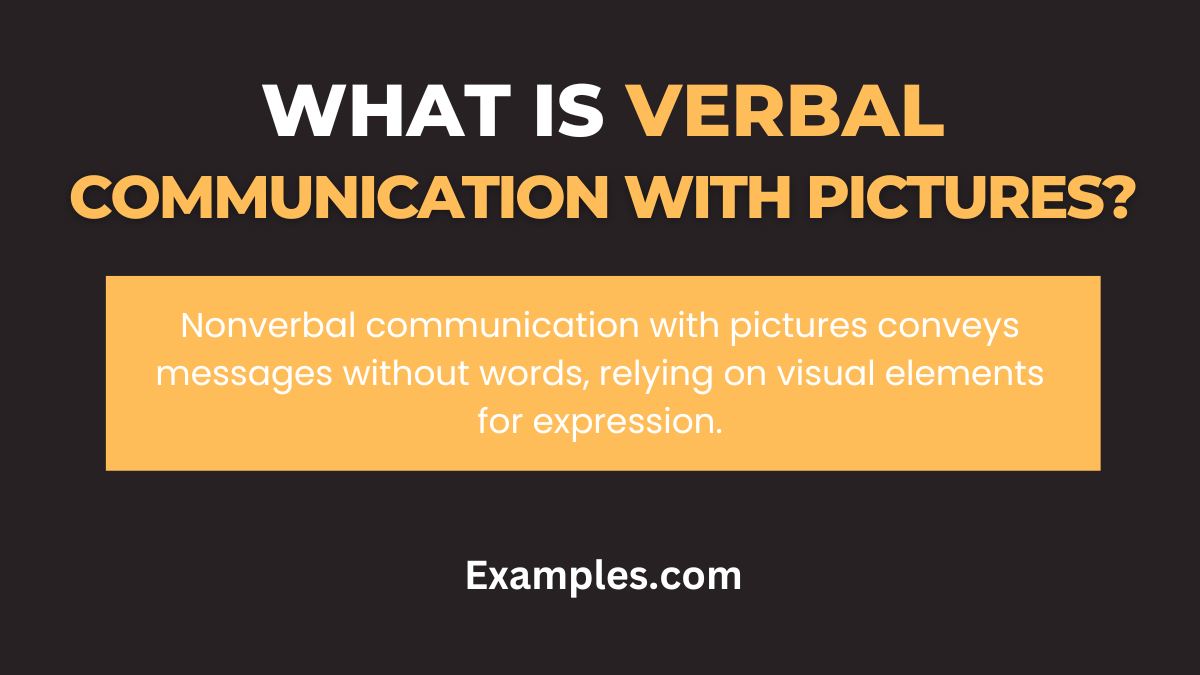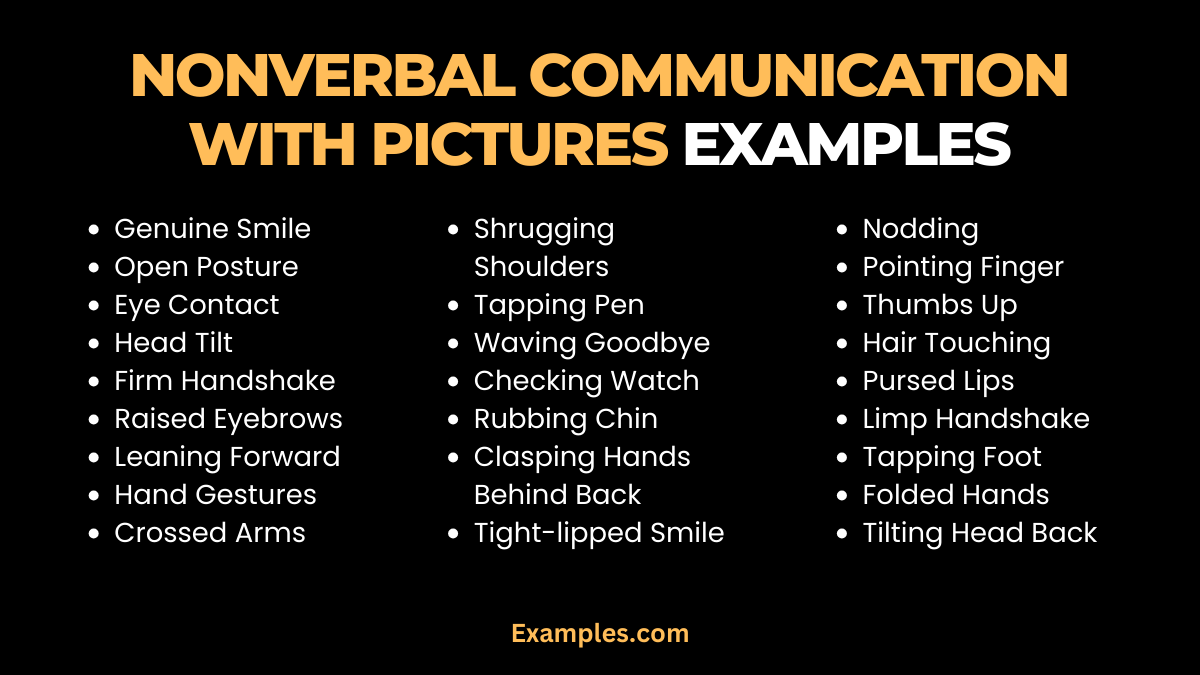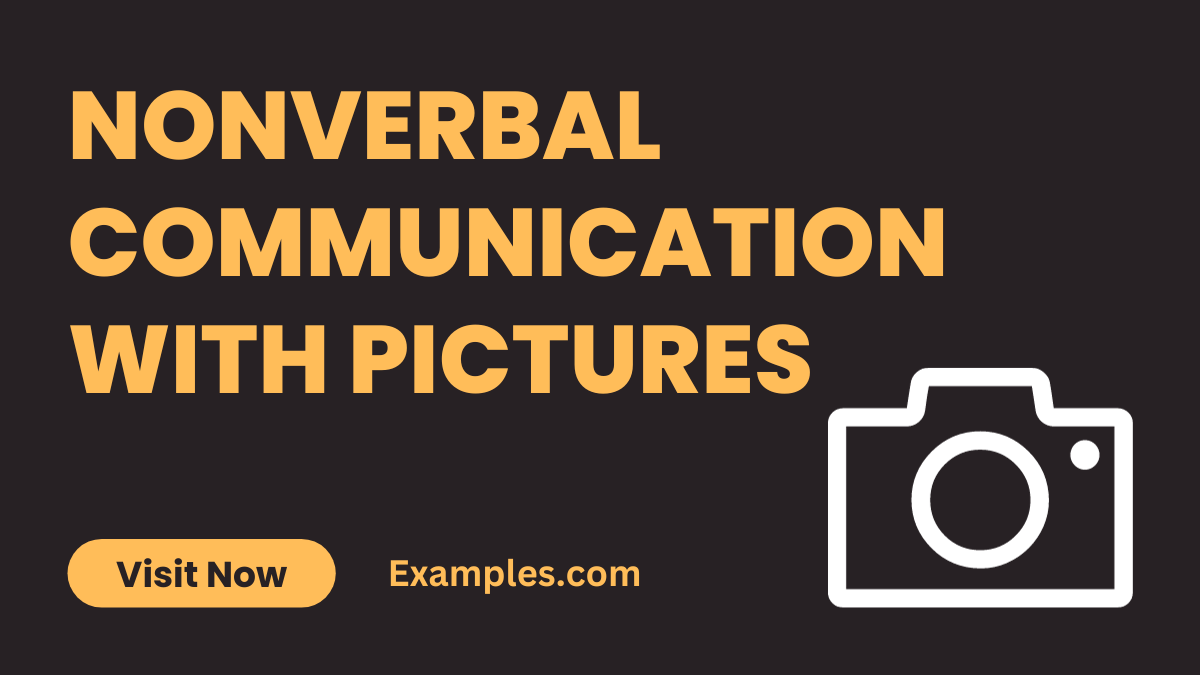29+ Nonverbal Communication With Pictures Examples
Unlock the profound impact of visual language in our extensive Nonverbal Communication with Pictures guide. Explore a rich array of Communication Examples to decode the silent cues within images. From subtle expressions to powerful gestures, this comprehensive resource unveils the intricacies of nonverbal communication through vivid examples. Enhance your understanding of this art form, gaining valuable insights into the unspoken language conveyed through every picture.
What is Nonverbal Communication with Pictures?

Nonverbal communication with pictures involves conveying messages and emotions through visual elements rather than words. This includes facial expressions, body language, and other visual cues that carry significant meaning. In simple terms, it’s the art of expressing without words, utilizing the power of images to communicate effectively. Understanding this form of communication is essential for interpreting and responding to the silent narratives embedded in various visual contexts.
30 Nonverbal Communication with Pictures Examples

Unlock the subtleties of human expression with our compilation of 30 Nonverbal Communication with Pictures Examples. Each image tells a unique story, showcasing the power of visual cues in effective communication. Explore the rich tapestry of nonverbal language through these captivating examples, enhancing your ability to decipher unspoken messages.
- Genuine Smile: A warm smile communicates sincerity and establishes trust. Example: In a job interview, a genuine smile can convey confidence and approachability.
- Open Posture: Arms uncrossed and relaxed posture signal openness. Example: During a team meeting, maintaining an open posture fosters collaboration and inclusivity.
- Eye Contact: Sustained eye contact conveys attentiveness and engagement. Example: In public speaking, maintaining eye contact builds a connection with the audience.
- Head Tilt: A slight head tilt shows interest and empathy. Example: During a conversation, a subtle head tilt indicates active listening and understanding.
- Firm Handshake: A firm handshake signifies confidence and professionalism. Example: In business settings, a strong handshake leaves a positive first impression.
- Raised Eyebrows: Raising eyebrows can express surprise or curiosity. Example: When discussing innovative ideas, raised eyebrows highlight enthusiasm and interest.
- Mirroring Gestures: Mimicking gestures builds rapport and connection. Example: Mirroring a colleague’s gestures fosters a sense of camaraderie during collaborative projects.
- Leaning Forward: Leaning in signals engagement and active participation. Example: During negotiations, leaning forward conveys interest and eagerness to reach an agreement.
- Hand Gestures: Expressive hand movements emphasize points and add emphasis. Example: Using hand gestures while presenting enhances the clarity and impact of your message.
- Crossed Arms: Crossed arms may indicate defensiveness or resistance. Example: In conflict resolution, crossed arms signal the need for a more open and understanding conversation.
- Nodding: Nodding signifies agreement and acknowledgment. Example: While listening, nodding reinforces that you comprehend and align with the speaker’s message.
- Pointing Finger: Pointing can emphasize direction or draw attention. Example: In guiding someone, a pointing finger adds clarity to instructions.
- Frowning Expression: A frowning expression conveys concern or disapproval. Example: In customer service, addressing concerns with empathy helps alleviate frowns.
- Thumbs Up: A thumbs-up gesture indicates approval and encouragement. Example: Offering a thumbs-up during a presentation boosts the speaker’s confidence.
- Hair Touching: Touching hair may signify nervousness or uncertainty. Example: During job interviews, minimizing hair-touching projects professionalism.
- Pursed Lips: Pursed lips may indicate thoughtfulness or disagreement. Example: When considering options, pursed lips reveal contemplation.
- Limp Handshake: A limp handshake can convey lack of confidence. Example: In networking, a firm handshake fosters a positive and memorable impression.
- Tapping Foot: Foot tapping may express impatience or anxiety. Example: During presentations, minimizing foot tapping maintains a composed demeanor.
- Rubbing Hands Together: Rubbing hands may signal anticipation or excitement. Example: Before a crucial meeting, rubbing hands together can help alleviate nervous tension.
- Folded Hands: Folded hands suggest patience or contemplation. Example: In discussions, folded hands demonstrate a composed and reflective demeanor.
- Raising Index Finger: Raising an index finger signifies emphasis or making a point. Example: In teaching, raising the index finger emphasizes key concepts.
- Head Nodding with Smile: Nodding with a smile expresses agreement and positive affirmation. Example: During team discussions, this combination fosters a supportive atmosphere.
- Shrugging Shoulders: Shoulder shrugging may indicate uncertainty or lack of knowledge. Example: In Q&A sessions, a shrug prompts the need for further clarification.
- Tapping Pen: Tapping a pen can suggest impatience or restlessness. Example: In meetings, minimizing pen tapping maintains focus and professionalism.
- Waving Goodbye: Waving goodbye signals a friendly and respectful departure. Example: In social settings, a wave conveys warmth and appreciation.
- Checking Watch: Glancing at a watch may indicate time awareness or urgency. Example: During presentations, discreetly checking the watch ensures adherence to schedules.
- Rubbing Chin: Rubbing the chin suggests contemplation or thoughtful consideration. Example: In brainstorming sessions, this gesture signals deep engagement in idea generation.
- Clasping Hands Behind Back: Clasping hands behind the back signifies confidence and composure. Example: During leadership discussions, this stance exudes assurance and control.
- Tilting Head Back in Laughter: Tilting the head back in laughter expresses genuine amusement. Example: In social gatherings, laughter with a tilted head fosters a positive, relaxed atmosphere.
- Tight-lipped Smile: A tight-lipped smile may indicate reservation or politeness. Example: In diplomatic negotiations, a tight-lipped smile conveys diplomacy and restraint.
Nonverbal Communication with Pictures Examples for Students with Disabilities
Empower students with disabilities through Nonverbal Communication with Pictures Examples tailored to their unique needs. This guide illuminates the diverse ways visuals aid communication, fostering an inclusive educational environment. Explore impactful examples designed to enhance engagement and understanding, ensuring a supportive learning experience for all.
- Symbolic Sign Language Chart: Enhance communication with students using a symbolic sign language chart, facilitating inclusive interaction in diverse classrooms.
- Color-Coded Visual Schedules: Create a color-coded visual schedule to assist students in understanding daily routines and transitions more effectively.
- Interactive Emotion Cards: Utilize interactive emotion cards to encourage students to express their feelings nonverbally, fostering emotional intelligence.
- Tactile Communication Board: Implement a tactile communication board for students with visual impairments, promoting nonverbal expression through touch.
- Picture-based Storytelling: Engage students in picture-based storytelling activities, promoting creativity and communication skills in an accessible format.
Nonverbal Communication with Pictures Examples for the Workplace
Description: Navigate the professional landscape with Nonverbal Communication with Pictures Examples tailored for the workplace. This resource unveils the power of visual cues in fostering effective communication, enhancing collaboration, and establishing a positive corporate culture.
- Professional Posture Guide: Develop a professional posture guide to encourage employees to convey confidence and competence through body language.
- Visual Team-building Activities: Implement visual team-building activities to strengthen interpersonal relationships and communication within the workplace.
- Gesture Recognition Training: Provide gesture recognition training to enhance cross-cultural communication and avoid misunderstandings in diverse work environments.
- Visual Project Timelines: Communicate project timelines visually, ensuring all team members have a clear understanding of deadlines and milestones.
- Expressive Emoji Feedback: Incorporate expressive emojis in digital communications to add a human touch and convey emotions efficiently.
Nonverbal Communication with Pictures Examples for Health and Social Care
In health and social care settings, effective communication is crucial. Explore Nonverbal Communication with Pictures Examples tailored for this context, emphasizing empathetic interactions, and facilitating understanding between caregivers and recipients.
- Visual Pain Scale: Implement a visual pain scale to help patients express pain levels nonverbally, facilitating more accurate healthcare assessments.
- Body Language in Counseling Sessions: Train healthcare professionals to recognize and interpret patients’ body language during counseling sessions for improved empathy.
- Interactive Health Storyboards: Develop interactive health storyboards to visually guide patients through treatment plans and procedures.
- Symbolic Communication Cards: Introduce symbolic communication cards for nonverbal patients, aiding in expressing basic needs and preferences.
- Visual Nutrition Guides: Create visual nutrition guides to assist individuals with dietary restrictions, promoting healthier choices in care settings.
What is Nonverbal Communication with Pictures in Everyday Life?
Nonverbal communication with pictures in everyday life is the silent language we use to convey emotions, ideas, and messages through visuals rather than words. From facial expressions to gestures, these images play a vital role in our daily interactions, adding depth and nuance to our communication.
What is the Main Purpose of Nonverbal Communication with Pictures?

The main purpose of nonverbal communication with pictures is to enhance the clarity and impact of our messages. By leveraging visual elements, we enrich communication with added layers of meaning, fostering understanding and connection. This form of communication transcends language barriers, making it a universal and powerful means of expression.
Tips for Effective Nonverbal Communication with Pictures
- Clarity is Key: Ensure your pictures convey a clear and unambiguous message to avoid misinterpretation.
- Embrace Diversity: Use a variety of visuals to cater to diverse preferences and communication styles.
- Context Matters: Consider the context in which the pictures will be interpreted to ensure relevance and understanding.
- Consistency is Crucial: Maintain consistency in the use of visuals to establish a cohesive and recognizable communication style.
- Engage Emotions: Capitalize on the emotional impact of pictures to create a memorable and resonant communication experience.
Nonverbal communication, particularly through pictures, plays a pivotal role in enhancing our understanding of the unspoken language in various contexts. It’s not just about decoding facial expressions or body language, but about embracing a comprehensive form of communication that transcends words. This form of communication is particularly effective in its universal applicability, breaking down language barriers and enriching our interactions in everyday life, educational settings, professional environments, and health and social care.
For further exploration into the power of nonverbal communication, the Harvard Business Review offers insightful articles on effective body language in professional settings. Additionally, for a deeper understanding of nonverbal communication in educational contexts, especially for students with disabilities, resources from the National Center on Safe Supportive Learning Environments can be invaluable. These external resources align with the high standards of relevance and authority, providing additional, valuable perspectives to the audience of Examples.com.



